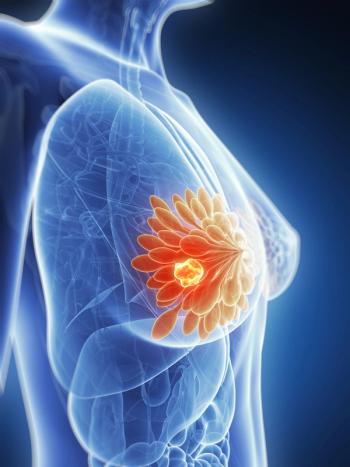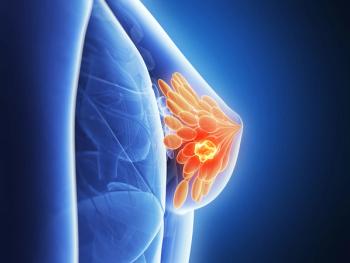
Oncology NEWS International
- Oncology NEWS International Vol 13 No 8
- Volume 13
- Issue 8
Benefits of SLN Biopsy Upheld in Large Trial
NEW ORLEANS-A large study from the United Kingdom has provided some of the first data from a randomized population in support of sentinel node biopsy (SNB) in breast cancer patients. Robert E. Mansel, MD, of the University of
NEW ORLEANSA large study from the United Kingdom has provided some of the first data from a randomized population in support of sentinel node biopsy (SNB) in breast cancer patients. Robert E. Mansel, MD, of the University of Wales College of Medicine, Cardiff, UK, presented the results at the 40th Annual Meeting of the American Society of Clinical Oncology (abstract 506).
Dr. Mansel noted that axillary clearance surgery is associated with arm-related morbidity, particularly numbness, pain, impaired mobility, and lymphedema. "Up to 83% of women actually have at least one symptom in the first 3 months, and some of these symptoms are very persistent," he said. "But the idea that sentinel node biopsy will have less morbidity is really based on intuition and not on real data. The studies supporting it are small and nonran-domized."
ALMANAC (Axillary Lymphatic Mapping Against Nodal Axillary Clearance) compared SNB with conventional axillary surgery in clinically node-negative breast cancer patients. The study used a unique quality-of-life measurement that was evaluated in 842 patients prior to randomization.
Surgeons Received Training
Surgeons underwent training in SNB technique at their institution, and those who achieved a set standard in the validation phasea localization rate of at least 90% and false-negative rate of 5% or lessperformed the procedure in the randomization phase.
"This is the first randomized multi-center trial to report data," Dr. Mansel said, "and provides one of the largest detailed datasets of quality of life in breast cancer."
The researchers randomized 1,031 patients with invasive breast cancer (T1-3, N0) to undergo SNB (n = 515) or standard axillary clearance or sampling (n = 516). Sentinel node identification was by a combined technique involving blue dye and radioisotope. Patients with positive sentinel nodes proceeded to axillary clearance or axillary radiation.
Patients were followed at 1, 3, 6, 12, and 18 months postoperatively, with the full 18-month follow-up completed by 61% of patients to date. Quality of life, arm morbidities, and axillary recurrence were the study endpoints.
"The surgeons, after training, were extraordinarily good at this procedure. In the whole sentinel node arm of the study, the failed localization rate was only 2% (11 of 515 patients)," Dr. Mansel reported. "Node positivity was equal in both groups [about 24%], and 92% of all patients had breast-conserving surgery."
The quality-of-life assessments were presented as an intention-to-treat analysis. This is important to note, Dr. Mansel said, because 20% of the SNB arm actually underwent axillary clearance as well, which would "weaken the differences between the SNB and conventional arms," he said.
Quality of life was determined by the FACT-B+4 instrument, with an additional arm morbidity subscale that evaluated swelling, pain, movement, numbness, and stiffness.
Improved Quality of Life
At 1 and 3 months, there was a highly significant difference between the SNB arm and the standard arm in quality-of-life factors, including overall quality of life and self-rated arm morbidity, which were diminished among patients undergoing standard treatment. While the score for the standard treatment group recovered somewhat, the value still remained below baseline.
Sensory loss, by physician assessment, occurred in 30.3% of patients with standard treatment, compared with 9.4% having SNB, for a significant threefold difference at 12 months. Mild arm swelling was noted, at up to 18 months, in 11.8% and 5.3%, while moderate-to-severe swelling was noted in 5.2% and 1.8%, respectively, which were highly significant differences, Dr. Mansel reported.
Time to return to normal activities, hospital stay, axillary operative time, drain usage, and incidence of infection were also significantly less in the SNB group. In fact, all subscales of the quality-of-life measures, including physical, functional, and breast cancer concerns, significantly favored the SNB arm.
These highly significant decreases in quality of life with standard axillary clearance were not obtained at the cost of raised anxiety in the SNB group, he added. According to the Spielberger State Anxiety instrument, patients undergoing SNB did not have greater concerns about residual cancer.
"This was the first large multicenter randomized trial of SNB to report on quality of life. In the first 3 months after surgery, SNB was superior in terms of arm morbidity. Arm swelling and sensory loss were highly significantly reduced with SNB, but, importantly, anxiety was not significantly heightened," Dr. Mansel said. "These data confirm that trained surgeons should offer sentinel node biopsy as the standard of care for small clinically node-negative breast cancers, provided long-term data show no recurrence or survival disadvantage."
Articles in this issue
over 21 years ago
Gemcitabine/Taxol: Another New Standard in Metastatic Caover 21 years ago
Statins Cut Colon Ca Risk in Half in Retrospective Studyover 21 years ago
Breast Cancer Regimen Is Dose Dense, Dose IntenseNewsletter
Stay up to date on recent advances in the multidisciplinary approach to cancer.

















































































